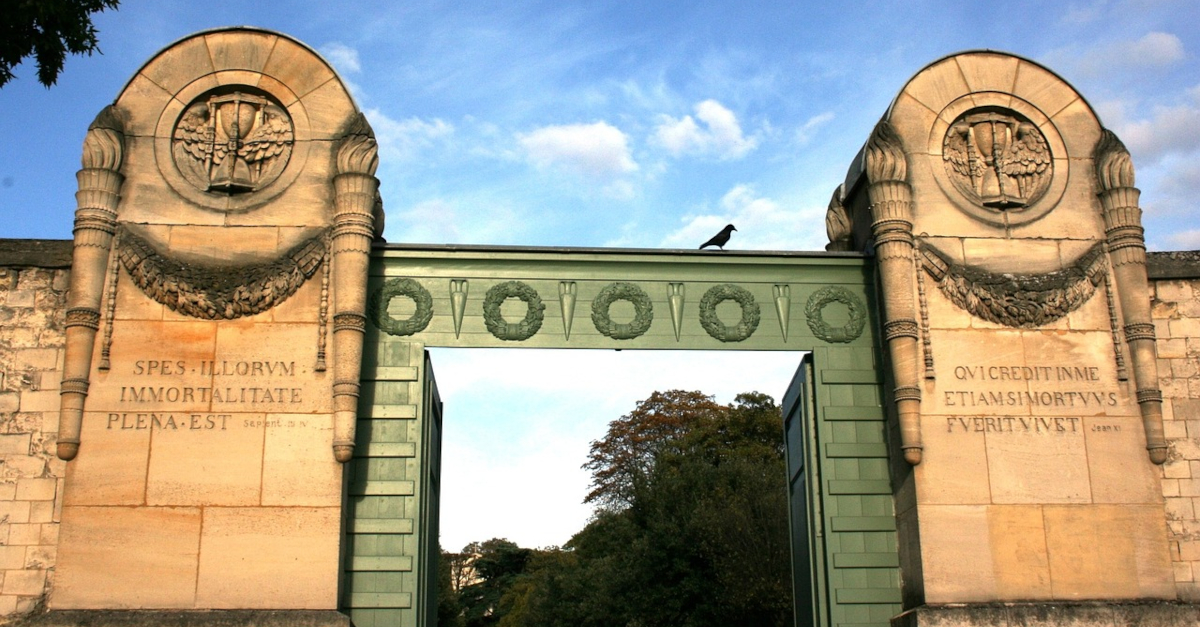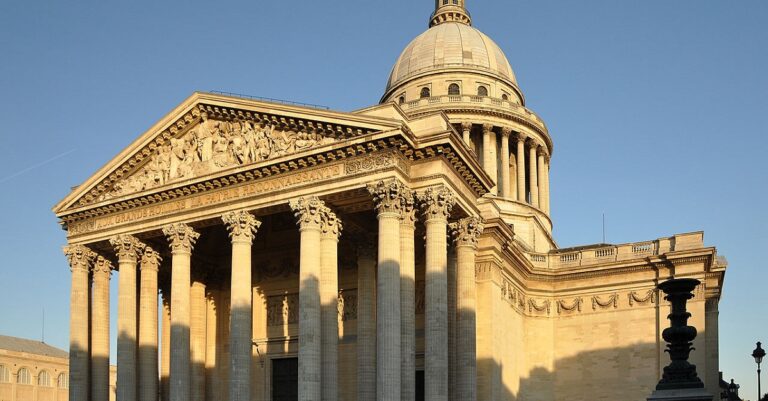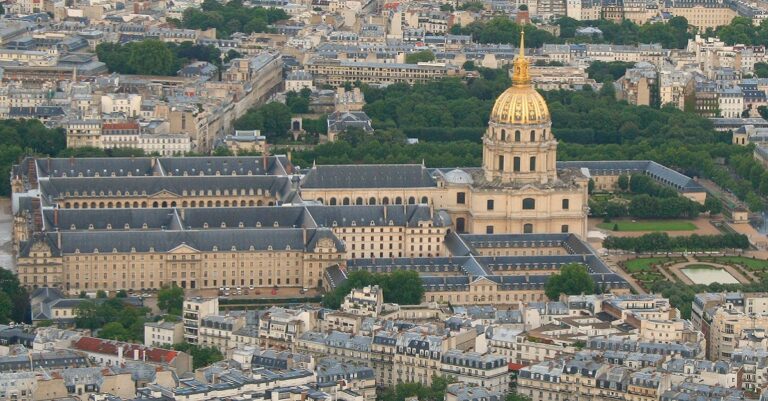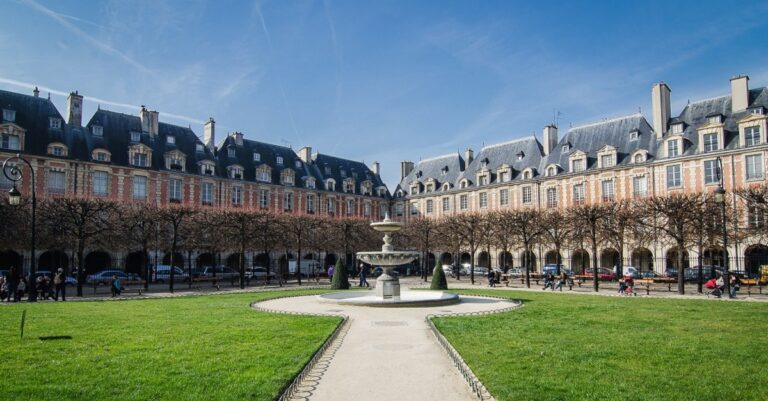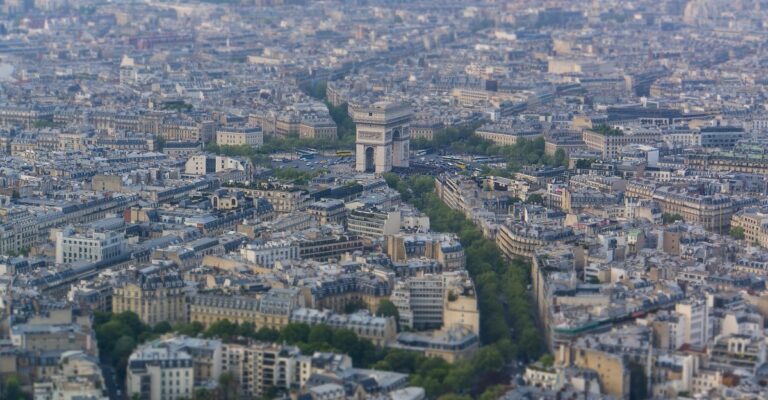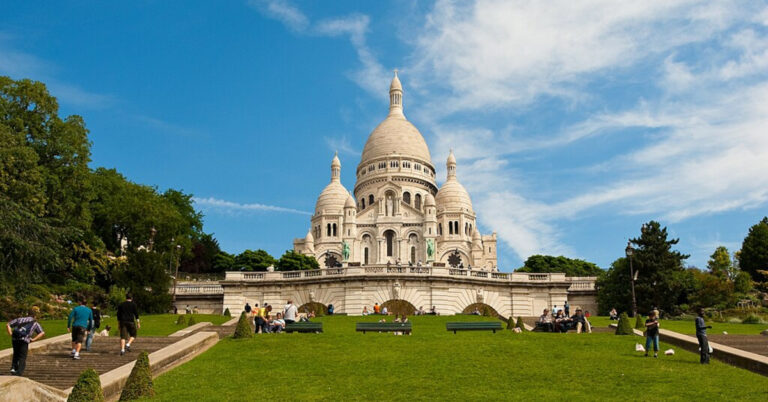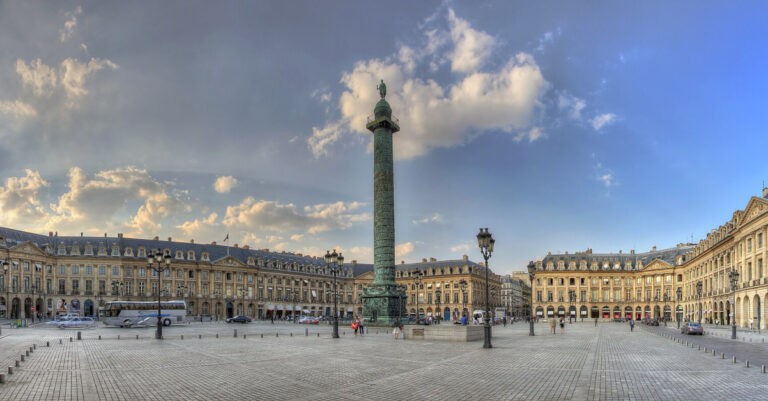The 22 Most Famous tombs at Père Lachaise Cemetery
The celebrities buried at Père-Lachaise are numerous, and their tombs hold many mysteries that we will discover.
The tombs of famous men of letters
-
Georges Rodenbach and his rose
-
Alfred De Musset buried beside a willow tree
-
Marcel Proust
-
Apollinaire and his love letters to his mistress
-
The tombs of Molière and Jean De La Fontaine, moved to attract crowds
-
Honoré de Balzac and La Comédie Humaine
-
Oscar Wilde and the lipstick marks
The tombs of legendary painters
-
Théodore Géricault and his painting
-
The magnificent sepulcher of Eugène Delacroix
-
Camille Pissarro buried in the Jewish division
The tombs of famous composers and singers
-
Henri Salvador
-
Edith Piaf, buried among her lovers
-
Frédéric Chopin, separated from his heart
-
Jim Morrison, the most visited tomb at Père-Lachaise
The unusual tombs
-
Fernand Arbelot and his passionate love
-
Pierre and Héloïse Abélard, the cursed lovers
-
The curse of Countess Demidoff
-
The ritual at the tomb of Allan Kardec
-
The most erotic tomb of Père-Lachaise: that of Victor Noir
-
The final fellatio of Félix Faure
We invite you to take our tour at Père-Lachaise and discover the secrets of its most beautiful tombs
The tombs of famous men of letters
-
Georges Rodenbach and his rose
-
Alfred De Musset buried beside a willow tree
-
Marcel Proust
-
Apollinaire and his love letters to his mistress
-
The tombs of Molière and Jean De La Fontaine, moved to attract crowds
-
Honoré de Balzac and La Comédie Humaine
-
Oscar Wilde and the lipstick marks
The tombs of legendary painters
-
Théodore Géricault and his painting
-
The magnificent sepulcher of Eugène Delacroix
-
Camille Pissarro buried in the Jewish division
The tombs of famous composers and singers
-
Henri Salvador
-
Edith Piaf, buried among her lovers
-
Frédéric Chopin, separated from his heart
-
Jim Morrison, the most visited tomb at Père-Lachaise
The unusual tombs
-
Fernand Arbelot and his passionate love
-
Pierre and Héloïse Abélard, the cursed lovers
-
The curse of Countess Demidoff
-
The ritual at the tomb of Allan Kardec
-
The most erotic tomb of Père-Lachaise: that of Victor Noir
-
The final fellatio of Félix Faure
If you wish to take our riddle-filled tour at Père-Lachaise and discover the secrets of its most beautiful tombs, click here.
Men of letters
Georges Rodenbach and his rose
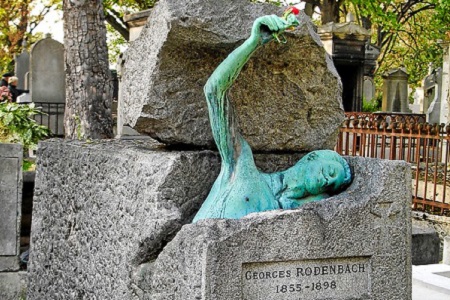
Georges Rodenbach was born in 1855 in Tournai and died in 1898 in Paris.
This Belgian poet and novelist came from a German bourgeois family.
Among the many verses he wrote, we find:
“What pride to be alone, hands against one’s brow,
Writing down verses gentle as a lyre’s chord,
And thinking of death soon to come, to say to oneself:
Perhaps I’m writing things that will live on!”
“Dreams are the keys for getting out of ourselves.”
“The eyes are the windows of the soul.”
On his grave, Georges Rodenbach holds a rose in his hand.
Alfred de Musset and his willow tree
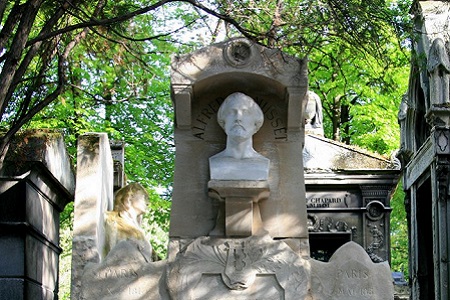
Alfred de Musset (1810–1857) is recognized as one of the greatest French Romantic writers.
At 19 he published Contes d’Espagne et d’Italie (Tales of Spain and Italy), his first poetry collection.
After this success he led a bohemian life while writing several plays, including his most famous work, Lorenzaccio.
Lorenzaccio tells the story of the young man Lorenzo who wants to kill Duke Alessandro de’ Medici, his distant cousin whom he judges too tyrannical; to reach his goal he contrives to win the duke’s trust. He ends up killing him, but he too dies.
Musset’s talent was recognized: in 1845 he received the Légion d’honneur, and in 1852 he was elected to the Académie française.
Discover a secret about Alfred de Musset’s tomb in our mobile tour of Père-Lachaise.
Marcel Proust
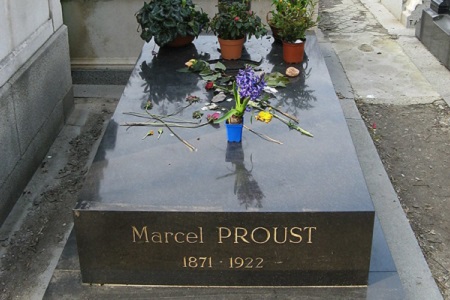
Marcel Proust (1871–1922) is a famous French writer whose principal work is a suite of seven novels titled In Search of Lost Time, published between 1913 and 1927.
This masterpiece recounts the lives of French people in the 20th century drawn from the author’s own memories. Through the novel he shares his reflections on Life, Man, and Time.
La tombe d’Oscar Wilde et le rouge à lèvres
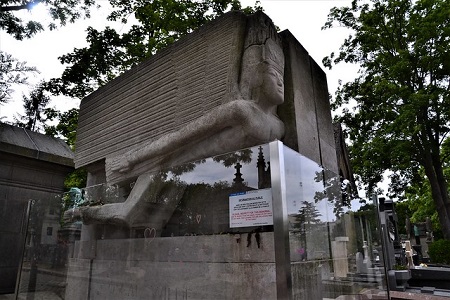
Oscar Wilde is a monument of European literature.
In the 1990s, the tomb became the object of an astonishing ritual.
Discover this unusual ritual through our tour of Père-Lachaise.
La tombe d’Honoré de Balzac et la Comédie humaine
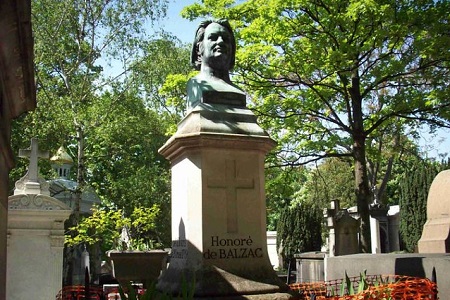
Honoré de Balzac (1799–1850) was a novelist, playwright, literary critic, art critic, essayist, journalist, and printer.
Discover the work that rests upon Honoré de Balzac’s tomb in our Père-Lachaise tour.
Moliere
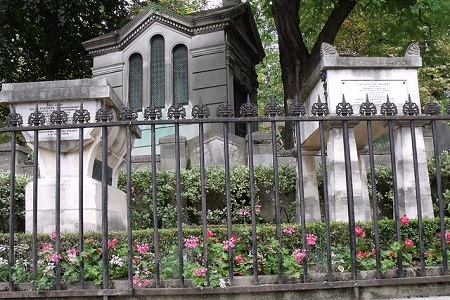
Jean-Baptiste Poquelin (1622–1673), better known as Molière, was a French troupe director and actor.
In his various comic works, he sought to make his audience laugh by creating characters, costumes, and slapstick gestures, and also to please the king, who protected and financed him.
He wrote The Miser; its main character, Harpagon, is defined by a caricatural miserliness.
He stirred up many controversies, notably with Tartuffe, which was banned for offending religion.
He composed and acted in The Imaginary Invalid. In this work, he denounces the absurdity of the medicine of his time. He died on stage during the fourth performance.
This man so profoundly marked French culture that French is commonly referred to as “the language of Molière.”
La tombe de Jean De La Fontaine

Jean de La Fontaine was a renowned French poet, chiefly for his Fables like The Crow and the Fox, with a moral intent.
He exclaimed: “I use animals to instruct men.”
Discover how this tomb made Père-Lachaise the most visited cemetery in the world in our Père-Lachaise tour.
Apollinaire and the love poems to his mistress
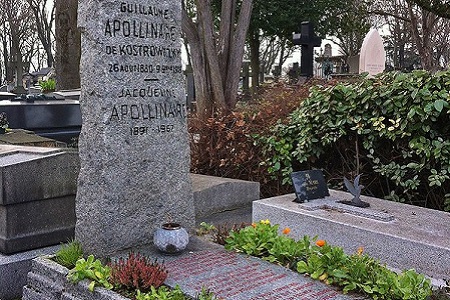
Guillaume Apollinaire (1880–1918) is one of the most famous French poets.
He notably wrote:
-
Zone, a poem praising modernity and the evolutions that improve human life.
-
The Song of the Poorly Loved, a melancholic poem inspired by his failed love with Annie Playden.
-
The Mirabeau Bridge, which evokes the disappearance of love over time, with the Seine flowing under the Pont Mirabeau as metaphor.
On his tomb are the opening lines of The Mirabeau Bridge.
His grave lies right next to that of his mistress Marie Laurencin.
To honor Marie Laurencin’s last wishes, her body was placed in her coffin dressed in a pretty white dress, holding a love letter from Apollinaire in one hand and a rose in the other.
Alphonse Daudet and the medallion on his tomb
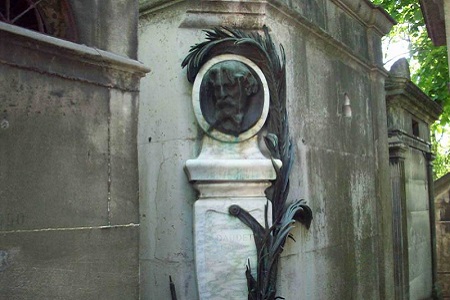
Alphonse Daudet (1840–1897) was a famous writer who quickly gained literary popularity upon coming to Paris; his writings always display a certain realism.
Daudet grew up in southern France and drew greatly on memories of his native region to write in 1866 his most accomplished work, Letters from My Windmill; this collection of tales includes stories widely known to the public, such as “Mr. Seguin’s Goat.”
He rests with his son in a very discreet family chapel, set back from the main alley.
A medallion bearing his likeness is on his tomb; this medallion is the work of Falguière.
The painters of Père-Lachaise
Théodore Géricault’s tomb with its painting
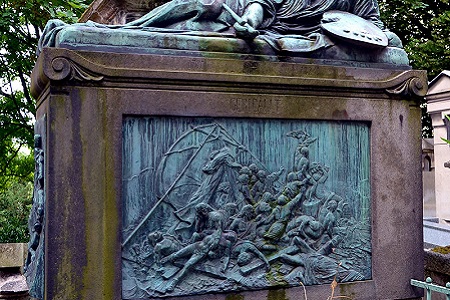
Théodore Géricault (1791–1824) is one of the greatest history painters of the 19th century.
Discover the story of the painting on Théodore Géricault’s tomb in our mobile tour.
Eugène Delacroix’s tomb in the form of a Roman sarcophagus
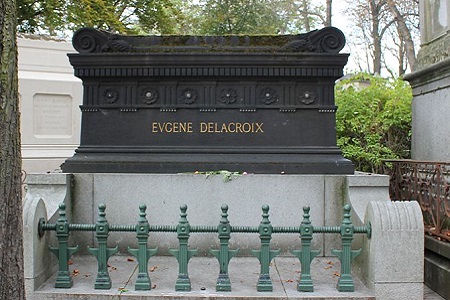
Eugène Delacroix (1798–1863) is a famous French painter, considered the standard-bearer of Romanticism.
An accomplished artist, he decorated the walls and ceilings of numerous monuments and painted on canvas.
The majority of his works draw on historical events and his travels.
Such is the case for his celebrated work exhibited at the Louvre: Liberty Leading the People.
This masterpiece depicts a woman, her chest partly uncovered, holding a rifle in one hand and in the other the French tricolor flag. The painting symbolizes liberty and democracy.
Eugène Delacroix wished to be noticed after his death.
He wanted his tomb to resemble the sarcophagus of Scipio Barbatus (a statesman and general of the Roman Republic).
Camille Pissarro buried in the Jewish division of Père-Lachaise
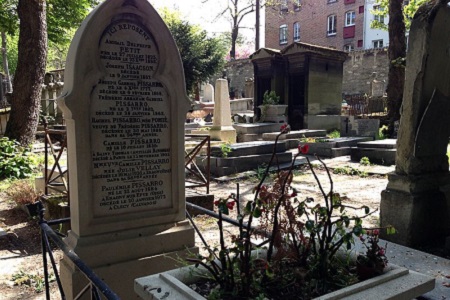
Camille Pissarro (1830–1903) is a famous Franco-Danish Impressionist painter.
He primarily painted rural landscapes and views of Paris:
-
The Poultry Market, Pontoise (1882)
-
White Frost (1873)
-
The Jallais Hill, Pontoise (1867)
-
Boulevard Montmartre, Night Effect (1897)
He is buried at Père-Lachaise in the Jewish division.
The law of June 1804 permitted cemeteries to be divided according to different faiths.
The Jewish section of Père-Lachaise opened on February 18, 1810, in Division 7.
The musicians, singers, composers of Père-Lachaise
Henri Salvador’s tomb with a date error
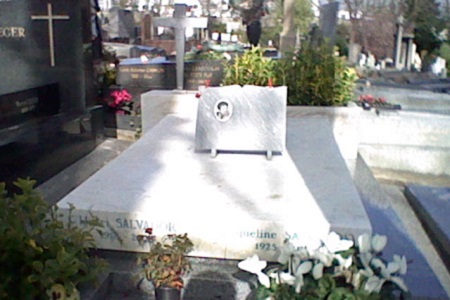
Henri Salvador (1917–2008), born in Guyana and deceased in Paris, is a famous French popular singer.
He is especially known for the songs:
“Syracuse,” “Maladie d’amour,” “Le Loup, la Biche et le Chevalier (Une chanson douce).”
His personal life was rather tumultuous:
he did not acknowledge his son, the photographer Jean-Marie Périer.
He also very frequently had violent arguments with his older brother.
His tomb lies right next to that of Édith Piaf in Division 97 of Père-Lachaise.
There is an error on his grave: it says he was born in 1918 instead of 1917.
Édith Piaf buried among her lovers
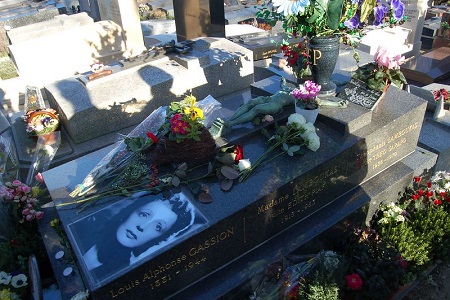
Édith Piaf (1915–1963) is known as a French singer and actress.
Nicknamed “La Môme,” her most famous songs include: La Vie en rose (1945), Hymne à l’amour (1949), “Mon manège à moi” (1958), Milord (1959), and “Non, je ne regrette rien” (1960).
However, Édith Piaf’s life was not always rosy; she lived in poverty and ran away from home at 15 to sing in the streets.
She was discovered by Louis Leplée, who turned her into an idol acclaimed by all of Paris.
Her life was marked by several deaths—her daughter’s in 1935 and her husband’s in a plane crash in 1949.
She never fully overcame these ordeals and became completely dependent on morphine and alcohol; she died at age 47 of a brain aneurysm.
Édith Piaf is also known for her amorous excesses; she had an incalculable number of lovers, many much younger than she; at least three of her lovers are buried near her tomb.
The tomb of Frédéric Chopin separated from his heart
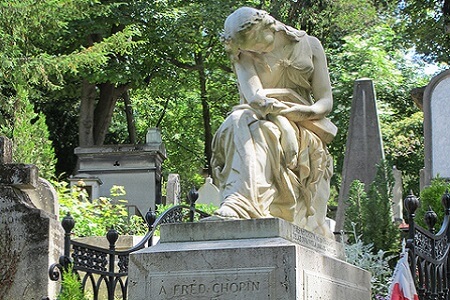
Frédéric Chopin was a Franco-Polish composer and virtuoso pianist, born in 1810 in Poland and died in 1849 in Paris.
At 7 years old, Chopin composed his first work.
At 8, he gave his first concert.
Of fragile health, Chopin died at 39.
Take our Père-Lachaise walk to discover why Chopin’s heart is not in his tomb.
Jim Morrison’s tomb, the most visited in Père-Lachaise
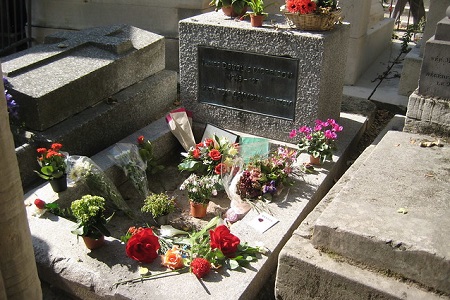
“ΚΑΤΑ ΤΟΝ ΔΑΙΜΟΝΑ ΕΑΥΤΟΥ.”
This Greek inscription on Jim Morrison’s tomb means “Faithful to his own demon.”
It aptly sums up the life of this famous American singer and poet, co-founder of the rock band The Doors.
This rocker, with his very excessive behavior and a lifestyle of “sex, drugs, and alcohol,” nevertheless showed commitment, particularly against the Vietnam War.
He died at 27 in Paris of a heart attack.
Alain Bashung the rocker
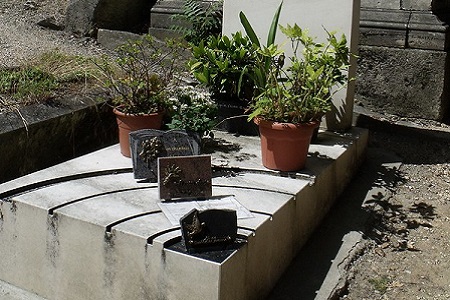
Alain Bashung (1947–2009) became famous in the 1980s as a rock singer.
He is the singer who received the most Victoires de la Musique in his career, with 13 awards.
Among his hit songs are:
-
“La nuit je mens”: a song about lies and resistance.
-
“Osez Joséphine”: dedicated to his friend Joséphine to help her overcome shyness.
-
“Madame rêve”: an evocation in the voice of a woman with whom he lived.
On his tomb in Père-Lachaise there are black circular arcs, resembling vinyl records. These engravings evoke his life as a singer.
The unusual tombs of Père-Lachaise
Fernand Arbelot and his passionate love
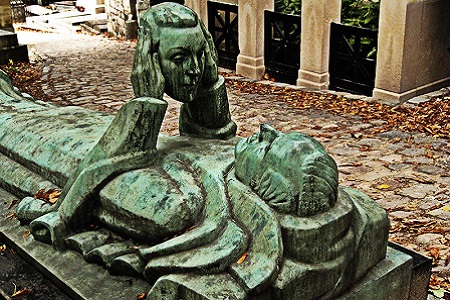
Fernand Arbelot’s tomb was created by Wansart and depicts Arbelot holding in his hands the face of his wife.
A passionate and eternal love that continues after death, symbolized by the epitaph on the tomb:
“Ils furent émerveillés du beau voyage / Qui les mena jusqu’au bout de la vie.”
(“They were amazed by the beautiful journey / That led them to the very end of life.”)
Pierre and Héloïse Abélard, the cursed lovers
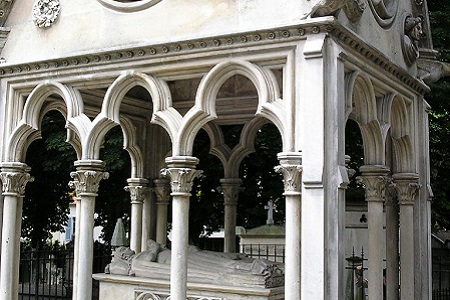
In the 12th century, Pierre Abélard, of noble birth, was a 36-year-old teacher to whom Canon Fulbert entrusted the education of his 17-year-old niece, Héloïse.
Teacher and pupil quickly fell in love—a forbidden love.
When Héloïse became pregnant, they went into exile in Brittany, where their son Astrolabe was born.
The young woman left the child with his paternal grandparents, and the lovers secretly married.
Canon Fulbert learned of this relationship and, furious, had Abélard emasculated as payback. Héloïse was “shut away” in the convent of her childhood.
Despite this separation, they continued to write to each other throughout their lives.
Legend has it that upon her death, Héloïse was transferred into her husband’s tomb, and that he took her in his arms to welcome her.
The curse of Countess Demidoff
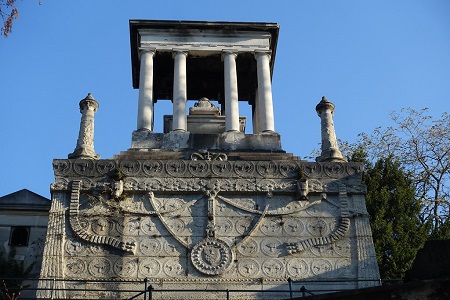
Countess Demidoff was a Russian aristocrat (1779–1818). At sixteen she married Nikolai Nikitich Demidov (Demidoff), from one of the wealthiest Russian families.
Discover the extravagances of the Countess’s will in our Père-Lachaise tour.
The tomb of Allan Kardec and its ritual

Allan Kardec was one of the initiators of Spiritism in Europe; he authored the discipline’s foundational books, such as The Spirits’ Book.
“To be born, die, be reborn again and keep progressing, that is the Law”—this phrase engraved on the monument sums up the precepts of reincarnation and the soul’s evolution that he staunchly defended throughout his life.
Discover the astonishing ritual at Allan Kardec’s tomb in our mobile tour at an unbeatable price.
Victor Noir’s tomb, the most erotic in Père-Lachaise
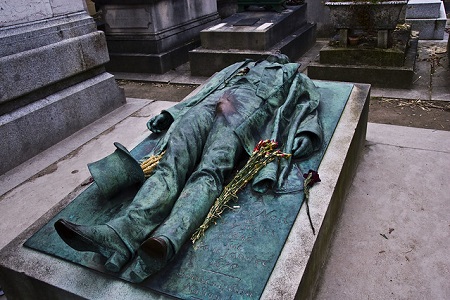
Victor Noir, a French journalist, was killed at age 21 because of the publication of an insulting article about Napoleon I’s nephew.
Discover the myth surrounding the virile attribute of Victor Noir’s tomb in our Père-Lachaise walk.
Félix Faure, the fatal treat
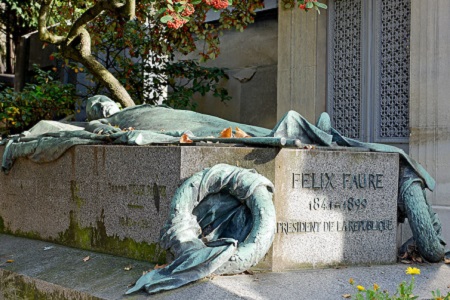
Félix Faure (1841–1899) is known as a French politician.
He rose with dazzling speed: from a modest family, he made a fortune as a leather trader, then began a political career—elected to the municipal council of Le Havre, then minister, and finally President of the Republic.
His term as president was marked by the Dreyfus Affair, which divided the French.
His death caused a sensation: he died of a stroke in his presidential office during fellatio with his mistress.
His tomb depicts him partly covered with the French flag.

